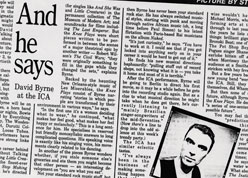ORIGINAL
PRESS CLIPPINGS

A STRONG DASH OF THE SHOWMAN
Bit by bit, we're getting to see Robert Wilson's 12-hour epic, "the CIVIL warS." Chunks have been produced in six countries, but plans to present the entire work at the 1984 Olympic Arts Festival in Los Angeles never materialized. Last season Robert Brustein's American Repertory Theatre in Cambridge, Mass., presented a three-hour segment known as the Cologne Section. Now the ART has followed up with the Knee Plays, the American Section, beginning a 10-city tour around the country. And in December the Next Wave Festival at the Brooklyn Academy of Music will spotlight the Rome Section. It's a hell of a way to see a show.
And a show is what "CIVIL warS" is — an American spectacle, despite the international circumstances of its creation. American artists have always had a strong dash of the showman, from Walt Whitman to D. W. Griffith to Frank Lloyd Wright, and the Texas-born, 44-year-old Wilson, despite his standing as king of the avant-garde, is right in this tradition. "Knee Plays" is a term from vaudeville, meaning the "joints" — or short routines — between the acts. Meant to be performed between the large sections of "CIVIL warS," these 13 scenes turn out to be an organic work in themselves, a crystalline distillation of the sweeping historical vision of "CIVIL warS."
"Knee Plays" (first done at Minneapolis's Walker Art Center in 1984) has an almost childlike quality in the changes it rings upon the central images of tree, boat, book and bird. As the scenes flow into one another, these elements undergo various adventures and transformations, merging in each other in a mythic précis of the cycle of civilization. The boat becomes a metaphysical ark, the Merrimack battling the Monitor, the frigate bearing Commodore Perry to greet the Japanese. Nine white-clad performers become a condensed version of humanity with its rituals, conflicts and transcendent possibilities. Suzushi Hanayagi's choreography whirls between Kabuki theater, bunraku puppetry, martial arts, gymnastics, cakewalks and Native American dances.
Driving the whole show is an extraordinary score by David Byrne of the rock group Talking Heads. Played by a superb seven-piece group called Les Misérables Brass Band, Byrne's music is one of the best theater scores of our time. What's amazing is the emotional force and color Byrne gets from his pastiche of elements ranging from New Orleans marches to early jazz to gospel songs to passages that sound like an exultant mutation of Richard Wagner, John Philip Sousa and Charles Ives. Byrne also wrote "lyrics" that evoke a futuristic anti-utopia where "everybody but the wealthy will be very happy . . . water will be expensive . . . machines will produce a religious experience . . ." There are passages where music, words, movement, design and lighting come together to produce a kind of magic idealism: Wilson the theatrical visionary produces the sweetest apocalypses in art. At the end, a giant heartbeat is heard, the dancers enter, roaming the stage, searching for something. The brass chords blare, a sound that seems like both taps and reveille, the end of all civil wars and the beginning of . . . what? Perhaps peace, rebirth, the joyous necessity of cultures coming together, as West and East have done in Wilson's theater.